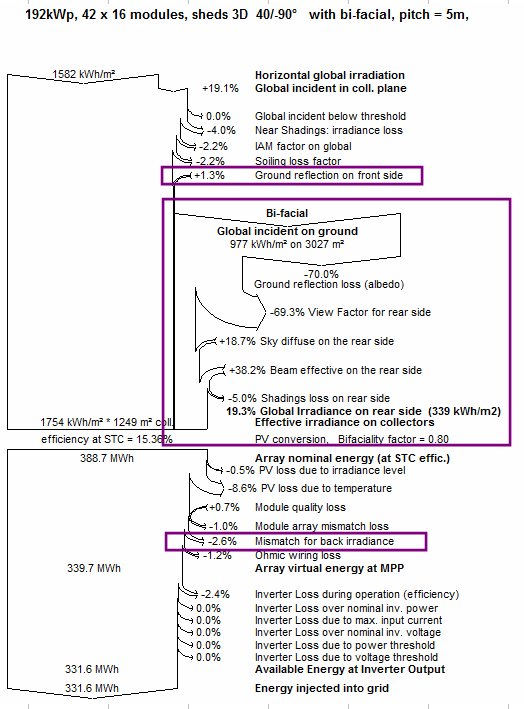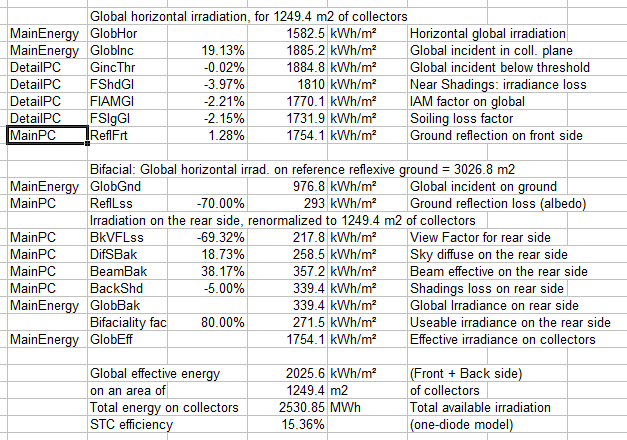The detailed results of the bifacial model are
available on the Loss diagram.
Here is an
example, with a description of all output variables involved.:

In the Report editor, you can also export
the values into Excel (menu "Export > Loss diagram
values) , which gives some explanations about how
to calculate some values:

Detailed variables
description:
| GlobGnd
|
Global incident on the ground.
|
|
|
This is the total irradiance reaching
the ground area below the installation (beam and diffuse).
|
|
|
This irradiance [W/m2] is referred to
the reflecting reference area (in 2D models:
proportional to the pitch). |
| ReflLss
|
Ground reflexion loss (albedo)
|
|
|
This is the loss of irradiance due to
the reflexion (1 - Albedo), referred to the ground reference
area
|
| BkVFlss
|
View factor for rear side
|
|
|
Each point of the ground is supposed
to receive an irradiance (luminous power) specific to its position
on the ground, and the sun's position.
|
|
|
After reflexion, this point will
re-emit the same power in all directions
(isotropic hypothesis, i.e.Lambertian distribution,),
according to the albedo factor. |
|
|
Now a part of this power will be
intercepted by the rear side of the collectors, the rest is lost
(sky). The view factor is the fraction of this interception for
each given point.
|
|
|
The total power received by the rear
side is the sum of all ground points contributions. This power will
result in an irradiance
[W/m²],
which is now normalised to the m² of collector area. |
|
|
Therefore when expressed as Irradiance
(not Power) this view factor should be multiplied by the Ground
area and divided by the Collector area (i.e. 1/GCR).
|
| DifSBak
|
Sky diffuse on the rear side
|
|
|
This is the contribution of the
diffuse irradiance, coming directly from the sky.
|
| BeamBak
|
Beam effective on the rear side
|
|
|
This is the contribution of the
eventual beam coming directly from the sun:
|
|
|
- with sheds, possible in the morning
and evening when the sun passes behind the East or West.
|
|
|
- with vertical East-West rows, when
the sun is opposite to the front side,
|
|
|
- with tracking systems, never.
|
| BackShd
|
Shading loss on rear side
|
|
|
Due to the mechanical structures
(corresponding to the specified "Structure shading
factor")
|
| GlobBak
|
Global irradiance on rear side
|
|
|
Is the sum of all these
contributions.
|
|
|
This value is mentioned in [kWh/m²],
and as a percentage of the GlobEff value
|
| EArrNom
|
Array Nominal energy at STC
efficiency
|
|
|
The reference energy of the array is
defined as the sum of:
|
|
|
- the GlobEff value,
multiplied by the PV modules area and the STC
efficiency,
|
|
|
- the GlobBak value, multiplied
by the PV modules area, the STC efficiency and the
bifaciality factor.
|
There are
2 other contributions linked to the bifacial model:
| MismBak
|
Mismatch for back irradiance
|
|
|
This is the result of the Mismatch
parameter specified by the user (see Bifacial
Procedure)
|
|
|
At this stage of the Array losses, on
the results diagram this is referred as percntage of the full
system energy.
|
|
|
As an example, if you have specified
a loss of 10% (of the bi-facial contribution), and you
have a bi-facial contribution of 15% of GlobEff, this will be 10%
of GlobBakEn / (GlobBakEn + GlobEff).
|
|
|
NB: Here the GlobBakEn is GlobBak *
Bifaciality factor
|
| ReflFrt
|
Ground reflexion on front side
|
|
|
This represent a contribution of the
irradiance reflected by the close ground (between rows), and
reaching the front side of the collectors (weighted by the IAM
loss, very significant here).
|
|
|
This contribution is indeed present in
any PV system (bifacial or not). However nobody takes it into
account, as its calculation involves the full Bi-facial model, with
an accurate definition of the ground, its albedo and the
geometry, and the full calculation of the ground points view
factors.
|
|
|
This contribution is very low with
sheds and trackers systems, but becomes crucial with vertical
East-West bifacial systems.
|

